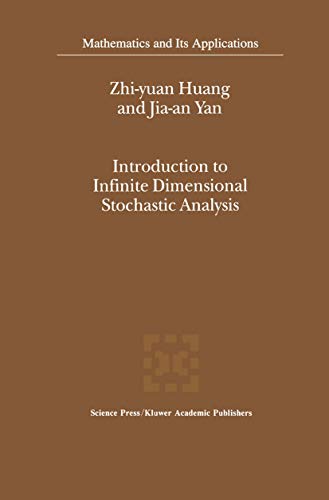
Synopsis
The infinite dimensional analysis as a branch of mathematical sciences was formed in the late 19th and early 20th centuries. Motivated by problems in mathematical physics, the first steps in this field were taken by V. Volterra, R. GateallX, P. Levy and M. Frechet, among others (see the preface to Levy[2]). Nevertheless, the most fruitful direction in this field is the infinite dimensional integration theory initiated by N. Wiener and A. N. Kolmogorov which is closely related to the developments of the theory of stochastic processes. It was Wiener who constructed for the first time in 1923 a probability measure on the space of all continuous functions (i. e. the Wiener measure) which provided an ideal math≠ ematical model for Brownian motion. Then some important properties of Wiener integrals, especially the quasi-invariance of Gaussian measures, were discovered by R. Cameron and W. Martin[l, 2, 3]. In 1931, Kolmogorov[l] deduced a second partial differential equation for transition probabilities of Markov processes order with continuous trajectories (i. e. diffusion processes) and thus revealed the deep connection between theories of differential equations and stochastic processes. The stochastic analysis created by K. Ito (also independently by Gihman [1]) in the forties is essentially an infinitesimal analysis for trajectories of stochastic processes. By virtue of Ito's stochastic differential equations one can construct diffusion processes via direct probabilistic methods and treat them as function≠ als of Brownian paths (i. e. the Wiener functionals).
"synopsis" may belong to another edition of this title.
Review
'The book is well written and nicely structured [...] will surely become a valuable resource for specialists in stochastic analysis as well as mathematical physicists.'
Mathematical Reviews (2002)
"About this title" may belong to another edition of this title.
Other Popular Editions of the Same Title
Search results for Introduction to Infinite Dimensional Stochastic Analysis
Introduction to Infinite Dimensional Stochastic Analysis
Seller: BookOrders, Russell, IA, U.S.A.
Hard Cover. Condition: Acceptable. No Jacket. Ex-library with the usual features. The interior is clean and tight. Binding is good. Cover shows light wear. 296 pages. Ex-Library. Seller Inventory # 036926
Introduction to Infinite Dimensional Stochastic Analysis
Seller: PAPER CAVALIER UK, London, United Kingdom
Condition: as new. Appears unread. May have a retail sticker on back cover or remainder mark on the text block. Seller Inventory # 9780792362081-2
Buy Used
Quantity: 1 available
Introduction to Infinite Dimensional Stochastic Analysis (Mathematics and Its Applications)
Seller: New Book Sale, London, United Kingdom
Hardcover. Condition: New. Usually Dispatched within 1-2 Business Days , Buy with confidence , excellent customer service. Seller Inventory # 079236208X--384
Buy New
Quantity: 1 available
Introduction to Infinite Dimensional Stochastic Analysis
Seller: GreatBookPrices, Columbia, MD, U.S.A.
Condition: New. Seller Inventory # 756472-n
Introduction to Infinite Dimensional Stochastic Analysis
Seller: Lucky's Textbooks, Dallas, TX, U.S.A.
Condition: New. Seller Inventory # ABLIING23Feb2416190183599
Introduction to Infinite Dimensional Stochastic Analysis
Seller: GreatBookPrices, Columbia, MD, U.S.A.
Condition: As New. Unread book in perfect condition. Seller Inventory # 756472
Introduction to Infinite Dimensional Stochastic Analysis
Seller: Ria Christie Collections, Uxbridge, United Kingdom
Condition: New. In. Seller Inventory # ria9780792362081_new
Buy New
Quantity: Over 20 available
Introduction to Infinite Dimensional Stochastic Analysis
Seller: GreatBookPricesUK, Woodford Green, United Kingdom
Condition: New. Seller Inventory # 756472-n
Buy New
Quantity: Over 20 available
Introduction to Infinite Dimensional Stochastic Analysis
Seller: BuchWeltWeit Ludwig Meier e.K., Bergisch Gladbach, Germany
Buch. Condition: Neu. This item is printed on demand - it takes 3-4 days longer - Neuware -The infinite dimensional analysis as a branch of mathematical sciences was formed in the late 19th and early 20th centuries. Motivated by problems in mathematical physics, the first steps in this field were taken by V. Volterra, R. GateallX, P. Levy and M. Frechet, among others (see the preface to Levy[2]). Nevertheless, the most fruitful direction in this field is the infinite dimensional integration theory initiated by N. Wiener and A. N. Kolmogorov which is closely related to the developments of the theory of stochastic processes. It was Wiener who constructed for the first time in 1923 a probability measure on the space of all continuous functions (i. e. the Wiener measure) which provided an ideal math ematical model for Brownian motion. Then some important properties of Wiener integrals, especially the quasi-invariance of Gaussian measures, were discovered by R. Cameron and W. Martin[l, 2, 3]. In 1931, Kolmogorov[l] deduced a second partial differential equation for transition probabilities of Markov processes order with continuous trajectories (i. e. diffusion processes) and thus revealed the deep connection between theories of differential equations and stochastic processes. The stochastic analysis created by K. Ito (also independently by Gihman [1]) in the forties is essentially an infinitesimal analysis for trajectories of stochastic processes. By virtue of Ito's stochastic differential equations one can construct diffusion processes via direct probabilistic methods and treat them as function als of Brownian paths (i. e. the Wiener functionals). 312 pp. Englisch. Seller Inventory # 9780792362081
Introduction to Infinite Dimensional Stochastic Analysis
Print on DemandSeller: moluna, Greven, Germany
Gebunden. Condition: New. Dieser Artikel ist ein Print on Demand Artikel und wird nach Ihrer Bestellung fuer Sie gedruckt. aThe infinite dimensional analysis as a branch of mathematical sciences was formed in the late 19th and early 20th centuries. Motivated by problems in mathematical physics, the first steps in this field were taken by V. Volterra, R. GateallX, P. Levy an. Seller Inventory # 5969240
Buy New
Quantity: Over 20 available

